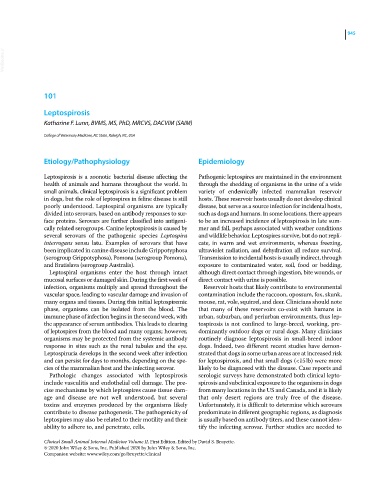Page 1007 - Clinical Small Animal Internal Medicine
P. 1007
945
VetBooks.ir
101
Leptospirosis
Katharine F. Lunn, BVMS, MS, PhD, MRCVS, DACVIM (SAIM)
College of Veterinary Medicine, NC State, Raleigh, NC, USA
Etiology/Pathophysiology Epidemiology
Leptospirosis is a zoonotic bacterial disease affecting the Pathogenic leptospires are maintained in the environment
health of animals and humans throughout the world. In through the shedding of organisms in the urine of a wide
small animals, clinical leptospirosis is a significant problem variety of endemically infected mammalian reservoir
in dogs, but the role of leptospires in feline disease is still hosts. These reservoir hosts usually do not develop clinical
poorly understood. Leptospiral organisms are typically disease, but serve as a source infection for incidental hosts,
divided into serovars, based on antibody responses to sur- such as dogs and humans. In some locations, there appears
face proteins. Serovars are further classified into antigeni- to be an increased incidence of leptospirosis in late sum-
cally related serogroups. Canine leptospirosis is caused by mer and fall, perhaps associated with weather conditions
several serovars of the pathogenic species Leptospira and wildlife behavior. Leptospires survive, but do not repli-
interrogans sensu latu. Examples of serovars that have cate, in warm and wet environments, whereas freezing,
been implicated in canine disease include Grippotyphosa ultraviolet radiation, and dehydration all reduce survival.
(serogroup Grippotyphosa), Pomona (serogroup Pomona), Transmission to incidental hosts is usually indirect, through
and Bratislava (serogroup Australis). exposure to contaminated water, soil, food or bedding,
Leptospiral organisms enter the host through intact although direct contact through ingestion, bite wounds, or
mucosal surfaces or damaged skin. During the first week of direct contact with urine is possible.
infection, organisms multiply and spread throughout the Reservoir hosts that likely contribute to environmental
vascular space, leading to vascular damage and invasion of contamination include the raccoon, opossum, fox, skunk,
many organs and tissues. During this initial leptospiremic mouse, rat, vole, squirrel, and deer. Clinicians should note
phase, organisms can be isolated from the blood. The that many of these reservoirs co‐exist with humans in
immune phase of infection begins in the second week, with urban, suburban, and periurban environments, thus lep-
the appearance of serum antibodies. This leads to clearing tospirosis is not confined to large‐breed, working, pre-
of leptospires from the blood and many organs; however, dominantly outdoor dogs or rural dogs. Many clinicians
organisms may be protected from the systemic antibody routinely diagnose leptospirosis in small‐breed indoor
response in sites such as the renal tubules and the eye. dogs. Indeed, two different recent studies have demon-
Leptospiruria develops in the second week after infection strated that dogs in some urban areas are at increased risk
and can persist for days to months, depending on the spe- for leptospirosis, and that small dogs (<15 lb) were more
cies of the mammalian host and the infecting serovar. likely to be diagnosed with the disease. Case reports and
Pathologic changes associated with leptospirosis serologic surveys have demonstrated both clinical lepto-
include vasculitis and endothelial cell damage. The pre- spirosis and subclinical exposure to the organisms in dogs
cise mechanisms by which leptospires cause tissue dam- from many locations in the US and Canada, and it is likely
age and disease are not well understood, but several that only desert regions are truly free of the disease.
toxins and enzymes produced by the organisms likely Unfortunately, it is difficult to determine which serovars
contribute to disease pathogenesis. The pathogenicity of predominate in different geographic regions, as diagnosis
leptospires may also be related to their motility and their is usually based on antibody titers, and these cannot iden-
ability to adhere to, and penetrate, cells. tify the infecting serovar. Further studies are needed to
Clinical Small Animal Internal Medicine Volume II, First Edition. Edited by David S. Bruyette.
© 2020 John Wiley & Sons, Inc. Published 2020 by John Wiley & Sons, Inc.
Companion website: www.wiley.com/go/bruyette/clinical

